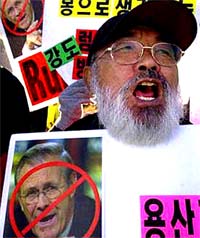
US Defense Secretary Donald H. Rumsfeld has arrived in Seoul, Republic of Korea Monday amid local anti-war controversy and protest over plans to send more South Korean troops to Iraq.
Nearly seven hundred South Korean soldiers, mostly medics and engineers are already in Iraq, and Washington is reportedly looking for several thousand more, including combat troops.
While South Korea is committed to sending troops to Iraq there is a difference of opinion between the allies over what type of troops will be sent -- and how many.
Professor Koh Byung-chul, of the Institute of Far Eastern Studies told CNN Monday, the US had asked for 5,000 troops, including combat forces, but South Korea wanted to limit the numbers to 3,000 people in mainly a non-combat role.
He said polls showed opinion in South Korea to be evenly divided on the troops issue, adding that it would be politically difficult for South Korean President Roh Moo-hyun to agree to the US request.
Riot police were deployed on the streets of the capital Sunday night when Rumsfeld arrived by helicopter at Yongsan Garrison, the 8th US Army's 320-hectare (800-acre) headquarters in the center of the city, the Associated Press reports.
In protests surrounding Rumsfeld's visit, activists denounced what they call Washington's pressure tactics and demanded President Roh reverse his troop decision.
While some South Koreans oppose sending any troops to Iraq, others believe the nation must be realistic and shoulder some international responsibility.
The issue is complicated by the presence of 37,000 US troops stationed in South Korea to defend against possible aggression by the Democratic People's Republic of Korea (DPRK).
Also South Korea and the United States are currently involved in a global effort to stop DPRK's nuclear weapons ambitions.
Maintaining good relations was especially crucial, Koh said, adding that the US and South Korean alliance would suffer greatly if Roh refused to boost the South Korean presence in Iraq.
This year marks the 50th anniversary of the US-South Korean security treaty following the end of the Korean War.
On Tuesday, Rumsfeld is scheduled to visit US troops, including soldiers of the 2nd Infantry Division, the main Army unit based in South Korea.
Asian strategy shift
South Korea is the third leg of Rumsfeld's six-day Asian trip. He has already visited Guam and Japan.
While in Tokyo, Rumsfeld downplayed Japan's decision to delay sending non-combat troops to Iraq which was prompted by the bomb attack on Italian troops that left 26, including 18 Italians, dead.
Rumsfeld said Washington is willing to wait for Japan to assess Iraq's security situation before sending its non-combat troops.
Japan has said it would like to send troops "as soon as possible" and dispatched a 10-member fact-finding team to Iraq Saturday to further assess the security situation.
Like South Korea, the Japanese public has been against the Iraq war and any involvement of Japanese forces there. That has left Prime Minister Junichiro Koizumi in an awkward position after promising the US support.
But getting help in Iraq is not the only item on Rumsfeld's agenda.
Washington is under pressure to reduce its Asian military presence as it realigns its forces around the world to increase flexibility in countering new security threats, such as terrorism.
There are almost 50,000 American forces in Japan, with two-thirds of that contingent based in Okinawa, which Rumsfeld visited on Sunday.
"I am in a listening mode and a looking mode," Rumsfeld said.
"I wanted to have a chance to look at the bases and get briefed by the military people on the island and develop a first-hand opinion about what's taking place there and how we're arranged."
During talks on Friday and Saturday, Rumsfeld presented Japanese leaders with plans for altering the US military "footprint" as part of a sweeping realignment of US forces around the world.
"But we don't have any specifics because it will take a great deal of discussion," he said at a press conference on Saturday.
The long-term US presence on Okinawa has sparked strong opposition from a section of the Japanese public.
(China Daily November 17, 2003)
|

